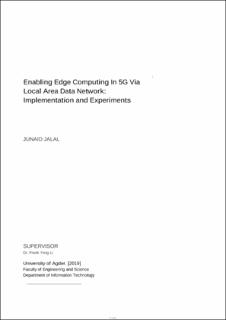| dc.contributor.author | Jalal, Junaid | |
| dc.date.accessioned | 2020-03-10T08:48:49Z | |
| dc.date.available | 2020-03-10T08:48:49Z | |
| dc.date.issued | 2019 | |
| dc.identifier.uri | https://hdl.handle.net/11250/2646128 | |
| dc.description | Master's thesis Information- and communication technology IKT590 - University of Agder 2019 | en_US |
| dc.description.abstract | The benefits of cloud computing are eclipsing when compared to other technologies, but the applications of cloud computing are very much cloud computing also has limitations due to its centralized architecture. The centralized cloud computing architecture gives rise to unnecessary delays which result in poor user experience. To avoid this, a decentralized cloud computing concept was introduced. In this concept computing and storage part of the cloud was to be moved as close to the user equipment as possible. By doing so the overall delays can reduce significantly which will enhance user experience. The decentralized approach is known as edge computing and is an integral part of 5G communication. Local Area Data Network (LADN) is a part of that architecture. The main purpose of LADN is to reduce the end to end delay that users experience while accessing data(audio/video/websites) from the Internet. This thesis is based upon the implementation of the LADN in 5G communication. Our main focus is to reduce latency or response time of requests. If implemented properly the number of requests that will need a response from the Internet will be reduced and will be serviced locally at the edge cloud. The reason behind this decision was that the demand for video/visual traffic on the Internet is increasing exponentially. It is also predicted that this trend will only increase with time. That being said the LADN can be implemented on all kinds of traffic and is a perfectly scalable solution. We implemented the LADN architecture by taking a Long-Term Evolution E-UTRAN Node B and connecting it with the Mobility Management entity server that hosted the 5G architecture inside its. Once we were able to access the Internet via the UE, we added a LADN server in the topology. We then connected the LADN server and the MME with the help of a switch. Then we tested if the LADN server was accessible via the UE. Once all this was set up, we performed the Ping, iPerf and traceroute tests to gather the data and to analyses the results. The results from the experiment revealed that the implementation of LADN will lead to lower RTT for the user and a higher data rate. It was also established that the number of hops a request has to travel was also reduced significantly. Therefore, the establishment of LADN will be very beneficial. | en_US |
| dc.language.iso | eng | en_US |
| dc.publisher | Universitetet i Agder ; University of Agder | en_US |
| dc.rights | Attribution-NonCommercial-NoDerivatives 4.0 Internasjonal | * |
| dc.rights.uri | http://creativecommons.org/licenses/by-nc-nd/4.0/deed.no | * |
| dc.subject | IKT590 | en_US |
| dc.title | Enabling Edge Computing In 5G Via Local Area Data Network : Implementation and Experiments | en_US |
| dc.type | Master thesis | en_US |
| dc.subject.nsi | VDP::Teknologi: 500::Informasjons- og kommunikasjonsteknologi: 550 | en_US |
| dc.source.pagenumber | 112 p. | en_US |

